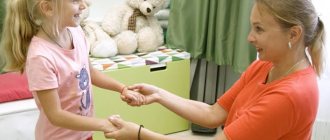General characteristics of preschool age
In modern psychology, preschool age is considered to be from 4 to 7 years. The beginning of this period is preceded by a crisis of three years. This is a rather difficult period in the life of parents, since the child shows extreme negativism and strong stubbornness.
It is this crisis that means that the child differentiates, separates from the mother and manifests itself as a separate person with his own opinions and desires. In order for him to successfully pass this stage, parents should under no circumstances humiliate or break the preschooler. You need to show him that he is heard, and he has the right to his experiences, but it is the right of adults to decide.
Having gone through this crisis, the child reaches a new level of relationships with adults. If earlier he was the “navel of the earth”, his mother’s continuation, now he becomes a separate person and a full member of the family. He must follow family rules, and his first responsibilities appear (putting away toys).
The boundaries of the family are revealed, and the child discovers the world around him. At this time, he usually begins to attend kindergarten, where he learns to interact with peers, as well as other adults. This is the first social role.
The desire for independence is an important characteristic of preschool age. The child strives to be an adult, but cannot yet be one. This is what gives rise to role-playing games as an opportunity to “play at being an independent adult.”
The preschooler tries to imitate his elders in everything, from intonation to gestures and behavior. At this age, a child, like a mirror, reflects his parents. This is a great opportunity for them to look at themselves from the outside and think about what they are teaching their children.
Game as a way of development
Preschool psychology defines play as a leading activity in the development of children of this age. What does "leading activity" mean? This means that it is this activity that has the main influence on the development of the child’s personality and all his mental processes.
During the game, the child learns to control his behavior according to the chosen role. This is how his voluntary behavior is formed. But you should not think that the game for the baby is just a fantasy, a pretense. No. For him, a game is an emotionally rich and absolutely real activity, where he can become anyone: a doctor, a salesman, a teacher, a knight or a princess.
Playing together helps children develop communication skills and also contributes to the emergence of social motives (achieving success, leadership).
During the process of role-playing play, the preschooler develops the following new formations:
- subordination of motives, that is, the ability to subordinate one’s personal desires to the rules of the game;
- learning the ability to communicate with other children. He masters the skills of interacting with peers, gaining both positive communication experiences (friendship, shared toys) and negative ones (grievances, quarrels);
- mastering the word “MUST”, and understanding that it is much stronger than the word “WANT”.
WHAT INFLUENCES THE DEVELOPMENT OF A PRESCHOOL CHILDREN'S PSYCHE?
Undoubtedly, the development of such a complex structure as the psyche is influenced by many different factors. These include, first of all, biological and social factors.
- Biological factors are heredity, features of the course of pregnancy and intrauterine development of the baby (the presence of diseases, infections, etc.), features of childbirth (complicated, rapid, cesarean section), the degree of full term of the child at the time of birth, and, accordingly, the degree of biological maturation of all of his systems and organs.
- Social factors include, first of all, environmental factors: natural and social. The natural environment affects the development of a child only indirectly. Climatic and geographical conditions determine certain types of work activity, as well as culture. This leaves an imprint on the characteristics of training and education. The social environment is the direct influence of society. It has a significant impact on the child’s mental development on two levels. These are macro and micro environments.
- Macroenvironment is society in a broad sense. That is, society with its cultural traditions, level of development of culture, art, religion, ideology, media... The child is included in various forms of activity, cognition and communication in accordance with accepted human culture and social experience. The program of mental development is formed by society and embodied through the system of training and education in surrounding social institutions.
- The microenvironment is the child’s immediate environment (his parents, family, neighbors, friends, teachers). The microenvironment has a significant influence on the early stages of a child’s mental development. It is family upbringing that plays the most important role in the development of a small personality. It determines many important aspects: features of communication and activity, self-esteem, creative and intellectual potential. Outside the social environment, no child can develop fully.
Try to create a favorable psychological microclimate in the family. This will contribute to the harmonious development of the baby’s psyche. Frequent scandals, constant stress and nervous tension are a powerful brake on this path.
Another important factor is the child’s involvement in various activities - play, work - as well as communication and learning.
Throughout life, interpersonal communication is of utmost importance for a person’s mental development. Through communication with adults, learning and education and the transfer of experience occur. Through communication, not only speech develops, but also voluntary memory, thinking, perception, attention, and important personality traits (character, temperament, behavior).
While playing, children reproduce characteristic ways of communication, as well as human interaction. The game helps the child develop his cognitive, moral, and personal qualities, assimilate important social roles and methods of activity, interaction of people in society. In the game, the socialization of the little personality occurs, the child’s self-awareness, his will, emotions, motivation, and needs develop.
The process of mental development is inseparable from labor. A child’s involvement in work activities affects all areas of the psyche.
Thus, in order to ensure the correct mental development of a child, it is important to take into account his biological characteristics, the specifics of the surrounding society, and also give him the opportunity to realize himself in play, study, work, and communication with people around him.
Cognitive processes of a preschooler
Preschoolers quickly develop all mental processes. A distinctive feature of all cognitive processes in preschool age is their acquisition of voluntariness.
In early preschool age (3-4 years), perception is closely related to the child’s emotions, and the more positive feelings and vivid impressions the child experiences when exposed to some stimulus, the more accurate the perception will be. But already at an older age (5-7 years), perception becomes not just a reaction to a stimulus, but a tool for understanding the world around us. Visual perception is especially developed in preschoolers.
Attention and memory retain their involuntary nature, but by the end of the period their volition develops. By the age of 5, the stability of attention and its volume increase. Moreover, it has been established that stability of attention is related to the character of the child. In calm children it is 2 times higher than in emotional ones.
The most important mental function affecting the development of a preschooler is memory. A child is able to remember a lot of different information, but only when he is interested, and this happens during the game. No special memorization techniques will work.
The development of a preschooler's thinking goes through several stages. At the beginning, the child develops visual-effective thinking, then - by the middle of preschool age - it turns into visual-figurative thinking, and at the end verbal-logical thinking begins to form.
These psychological features of the development of preschool children, and in particular the features of thinking, must be taken into account when communicating with a child. For example, a 4-5 year old child asks when mom will return home. You answer that she will come home after work. And a couple of minutes later the child asks the same question. No, he is not joking with you and he heard your answer well. Simply, due to the specifics of children's thinking, he did not understand it.
The words “after”, “then” belong to the category of time (past, present, future), and this relates to verbal-logical thinking. And the child operates visually and effectively. Therefore, so that the child understands you, list after what actions and events the mother will appear at home. For example: “You and I will go for a walk now, then we will eat, watch a cartoon, it will become dark outside the window, and then mom will come.”
Psychological characteristics of preschool age article on the topic
Psychological characteristics of preschool age
Preschool childhood is a large period of a child’s life. This age is a direct continuation of early age in terms of general sensitivity, carried out by the uncontrollability of the ontogenetic potential for development.
Living conditions at this time are rapidly expanding: the boundaries of the family are expanding to the limits of the street, city, and country. He feels a strong desire to be involved in adult life, to actively participate in it, which, of course, is not yet available to him. He strives for independence. From this contradiction, role-playing play is born - an independent activity of children that models the life of adults.
Social development situation
The child’s place in the system of relationships changes (he is no longer the center of his family), and the ability to identify with people and images of heroes of works of art develops. There is an assimilation of norms of behavior, as well as various forms of communication. The child begins to realize that he is an individual and acquires an interest in the physical structure of a person.
Leading activity in preschool age
A game. It has a significant impact on the development of the child. In the game, children learn to fully communicate with each other. In the process of role-playing games, children take on the roles of adults and the relationships between them. And although life in the game takes place in the form of ideas, it is emotionally rich and becomes his real life for the child.
The game contributes to the development of not only communication with peers, but also the child’s voluntary behavior. The mechanism for controlling one’s behavior develops precisely in the game, and then manifests itself in other types of activities.
The game develops the motivational-need sphere of the child. New motives for activity and goals associated with them arise. Qualitative changes occur in the child’s psyche. The preschooler also masters visual arts.
Central neoplasms: new internal position; subordination of motives, self-esteem and awareness of one’s place in the system of social relations.
Thinking
Thinking in preschool age is characterized by a transition from visually effective to visually figurative and at the end of the period to verbal thinking.
A preschooler thinks figuratively, but he has not yet acquired adult logic of reasoning. Solves mental problems in the representation, thinking becomes non-situational.
The prerequisites for such mental qualities as independence, flexibility and inquisitiveness are being formed.
There are attempts to explain phenomena and processes. Children's questions are indicators of the development of curiosity.
The mental development of a preschool child is constantly influenced by the gaming situation and actions. The child’s experience of gaming and real relationships in role-playing games forms the basis of a special property of thinking that allows one to take the point of view of other people, anticipate their behavior and, depending on this, build one’s own behavior.
Speech
By the age of seven, language becomes a means of communication and thinking of the child, as well as a subject of conscious study, since learning to read and write begins in preparation for school. According to psychologists, the child’s language becomes native.
The sound side of speech develops. Younger preschoolers begin to realize the peculiarities of their pronunciation. By the end of preschool age, the process of phonemic development is completed. The child's vocabulary is growing rapidly.
The child masters the grammatical forms of the language and actively increases his vocabulary, which allows him to move on to contextual speech at the end of preschool age. He can retell a story or fairy tale he has read, or convey his impressions of what he saw.
Features of speech development in preschool age:
- speech is detached from a specific situation, loses its situationality, turning into a universal means of communication;
- coherent forms of speech appear, its expressiveness increases;
- the child comprehends the laws of his native language in the process of acting with words;
- the child learns to express his thoughts coherently, logically, reasoning turns into a way of solving intellectual problems, and speech becomes a tool of thinking and a means of cognition, intellectualization of cognitive processes;
- speech turns into a special activity that has its own forms: listening, conversation, reasoning and stories;
- speech becomes a special type of voluntary activity, a conscious attitude towards it is formed.
Perception
Perception in preschool age loses its initially effective character: perceptual processes are differentiated. Perception becomes meaningful, purposeful, and analytical. It highlights voluntary actions - observation, examination, search.
In preschool age, the following is typical for perception:
- perception turns into a special cognitive activity;
— visual perception becomes one of the leading ones;
- perceiving objects and actions with them, the child more accurately evaluates color, shape, size;
— the ability to determine direction in space, the relative position of objects, and the sequence of events is improved.
Attention
In preschool age, there is a universal means of attention - speech. The child organizes his attention to the upcoming activity by formulating it verbally.
In this age:
— concentration, volume and stability of attention increase significantly;
— elements of arbitrariness in the control of attention are formed based on the development of speech and cognitive interests;
- attention becomes indirect;
- attention is related to the child’s interests in activities;
— elements of post-voluntary attention appear.
Memory
Preschool childhood is the age most favorable for memory development.
Younger preschoolers have involuntary memory. The child does not set a goal to remember or remember something and does not have special methods of memorization.
In middle preschool age (between 4 and 5 years), voluntary memory begins to form.
Memory, increasingly uniting with speech and thinking, acquires an intellectual character, elements of verbal-logical memory are formed.
The memory of a preschooler, despite its apparent external imperfection, actually becomes the leading function.
Imagination
Imagination is formed through playful, civic and constructive activities and, being a special activity, turns into fantasy. The child masters the techniques and means of creating images, and there is no need for visual support to create them.
By the end of preschool age, the child's imagination becomes controllable. Imagination actions are formed:
— a plan in the form of a visual model;
- image of an imaginary object;
- a way of acting with an object.
Development of the motivational sphere
The most important personal mechanism that develops in preschool age is considered to be the subordination of motives. It is with these changes in the child’s motivational sphere that the beginning of the formation of his personality is associated.
Already in early preschool age, a child can relatively easily make a decision in a situation of choosing one object from several, not to react to an attractive object. The image of another person (an adult, other children) helps a preschooler regulate his behavior. At first, the child needs someone to be nearby to control his behavior, and when left alone, he behaves more freely and impulsively. Then, as the conceptual plane develops, it begins to be held back by imaginary control.
At preschool age, the child is included in new systems of relationships, new types of
activities. The preschooler begins to assimilate the ethical standards accepted in society. He learns to evaluate actions from the point of view of moral norms and to subordinate his behavior to these norms.
Initially, the child evaluates only the actions of others - other children, without being able to evaluate his own.
Developing Self Awareness
A critical attitude to the assessment of adults and peers arises. Evaluating your peer helps you evaluate yourself.
Self-esteem appears in the second half of the period based on the initial purely emotional self-esteem (“I’m good”) and a rational assessment of other people’s behavior. A child judges moral qualities mainly by his behavior.
By the end of preschool age, correct differentiated self-esteem and self-criticism develop. The ability to motivate self-esteem develops.
Seven Years Crisis
The crisis of seven years is the period of the child’s social “I” (L.I. Bozhovich). It is associated with the emergence of a new systemic neoplasm - an “internal position”, which expresses a new level of self-awareness and reflection of the child.
Both the environment and the child’s attitude towards the environment change. The level of requests to oneself, to oneself, to one’s own success, position increases, and self-respect appears. There is an active formation of self-esteem.
There is a change in the main experiences:
- the very fact of experiences is revealed;
— a meaningful orientation in one’s own experiences arises;
- experiences take on meaning.
Thus, the seven-year crisis represents internal changes in the child with relatively minor external changes and social relationships between the child’s personality and the people around him.
The components of psychological readiness for school are:
- intellectual readiness (or, more broadly, readiness of the cognitive sphere);
— personal (including motivational);
— socio-psychological readiness;
— readiness of the emotional-volitional sphere.
Speech development
At preschool age, the centers responsible for speech functions mature in the child’s psyche, and the process of mastering native speech is completed. The little man's vocabulary increases significantly. At six years old, a child’s active vocabulary contains 2500-3000 words. This is three times more than that of a three-year-old child.
However, these indicators depend entirely on the environment in which children grow up. Preschoolers have a large vocabulary if their parents talk to them a lot and read fairy tales and stories with them (this is how they become familiar with literary speech).
This period is characterized by the so-called word creation of children - the ability to form bizarre forms of words or use words in an unusual meaning.
Leading needs of a preschooler
The psychology of preschool children often contains contradictions. For example, at this age they have two new needs:
- communication with other children;
- the need to be engaged in some activity important to society.
But the child cannot fulfill the second need in society. How can he resolve this contradiction? This is precisely what leads to the emergence of role-playing games, which enable preschoolers to play the roles of adults who are engaged in socially important activities.
An important need for a baby at this age is the need for acceptance and unconditional love. It is important for him to feel that he is special to his parents, and that he is loved simply for who he is. Parental acceptance and love creates a strong foundation for healthy self-esteem. Having matured, the child will not “curry favor” in order to earn love.
Unconditional love does not mean no punishment for wrongdoing. But parents need to separate personality and actions and punish the child precisely for his misdeeds, and not because he is “bad.” We need to explain to him that he is good and loved, but his parents must punish him for his misconduct.
Personal development
According to preschool psychology, in the period from 4 to 7 years the foundation of personality is laid: self-esteem, subordination of motives, assimilation of moral norms and rules, as well as the ability to evaluate and control one’s behavior.
Emotional development
The preschooler learns to name emotions and recognize their manifestations in himself and others. It is very important during this period to teach him a healthy attitude towards negative emotions and how to express them correctly. To do this, adults themselves must have well-developed emotional intelligence.
At this age, the child shows emotions such as empathy and care. “Social” emotions develop: a feeling of pride and joy for a good deed, a feeling of shame for a bad one.
Self-esteem and self-awareness
At this stage of development, the child develops the ability to evaluate his own actions and the actions of others. And it is then that self-esteem and self-image are formed.
Self-esteem is based on self-concept. Although it would be more correct to say: “You-concept,” since at first a preschooler’s self-image is formed from how his parents evaluate him. Therefore, parents should be careful in assessing their child and often pay attention to his strengths and abilities so that he grows up to be a confident person.
Moral development and hierarchy of motives
The preschooler actively learns the norms of behavior and morality and begins to think in moral categories: bad - good, kind - evil, honest - dishonest. Parents play a significant role in the moral development of a little person, and it is they who pass on their values to their children.
An important new development of this age is the subordination of personal motives to public ones. In early preschool age, children display personal motives, one of which is to gain the approval of a significant adult. At high school age, a subordination of motives occurs: personal motives give way to social motives (to do a good deed, or to obey the wishes of the group).
Knowledge of norms and rules of behavior, as well as the ability to evaluate one’s actions in older preschool age, leads to the fact that the child learns to control his actions and manage his behavior.
Gender
Awareness of oneself as a being of a certain gender is already present in three-year-old children. Moreover, at first, children can copy the behavior of a parent of the same sex - girls put on jewelry like their mothers, and boys conduct business conversations on a toy phone. As they grow up, they will try to behave accordingly: the daughter will ask to help in the kitchen, the boy will ask to repair the car with his grandfather.
It is interesting that preschoolers strive to be friends only with peers of the same sex: girls with girls, and boys with boys. In this case, disparaging statements towards the opposite sex are possible.
Creative development
There is no end to the creative flight of a child. The child’s imagination takes him far, far away. He is interested in drawing, sculpting, gluing, and much more. Encourage these activities. This is how his imagination develops, his talents and self-confidence are revealed.
Crisis periods
The psyche of preschool children is characterized by heterogeneous development. At the same time, the smooth formation is replaced by sharp jumps. During this period, the baby’s behavior and attitude towards external factors changes dramatically. The psychology of a preschooler and the characteristics of age-related development include 2 crises.
Crisis 3 years
At 2-4 years old, the baby begins to treat himself as a separate person. At the same time, there is a desire to act contrary to parents on every occasion. This helps to establish your own independence. The baby becomes almost uncontrollable. At the same time, persuasion, shouting and threats do not allow achieving the desired results.
At this age, the child arranges a kind of exam for his parents. It helps you test the boundaries of your own freedom. In a child’s speech one can increasingly hear phrases – I myself, I don’t want, I won’t.
Children are accustomed to feeling the weaknesses of their parents. That's why they try to play on them. It is strictly forbidden to follow the child's lead. He needs to formulate certain rules, breaking which is strictly prohibited.
At the same time, it is forbidden to be angry with the baby for showing self-will or stubbornness. Don't try to break him. Adults will be able to influence the child, trying to direct his attention to some interesting events.
In order for the baby to cry and throw tantrums less often, prohibitions should be presented in a diplomatic form. A sharp order to put on a hat should be replaced by giving him the opportunity to choose the color of the headdress.
Crisis 6–8 years
The symptoms of this crisis include the following:
- the appearance of an intellectual component between actions and emotions - the child during this period loses his spontaneity;
- the appearance of isolation and secrecy in relation to one’s feelings;
- the appearance of social emotions - the child feels pride for good actions and shame for bad actions;
- a decrease in the importance of previous interests, the emergence of motivation to study.
Children of this age have the ability to think logically and abstractly. They begin to need serious argumentation of parental demands. So, when reminded of the need to brush their teeth, a child may say: why brush baby teeth if they are going to fall out anyway?
Often a child develops traits that help him emphasize his maturity. So, a girl can paint her nails, imitating her older sister, and a boy tries to talk about politics.
To cope with the next crisis, you can start preparing your child for school. The educational institution attracts children because it helps them catch up with older children. At the same time, it helps to gain knowledge that adults possess.
The child begins to understand that society makes specific demands on him. The feeling of well-being is influenced by relationships with other people and approval in a social group. Before starting school, children are characterized by high self-esteem. At the same time, at school it is necessary to engage in new activities that are not like games.
When difficulties or problems arise in learning, there is a risk of a strong drop in self-esteem. At this stage, the child understands that he cannot do everything.
Pochemochki, greedy and brawlers
Preschool age is the age of a thousand and one questions. The baby is actively exploring the world, and he is interested in knowing everything: what the sun is made of, and why the bag rustles. Although sometimes these questions are inappropriate, always take the time to answer them. This way you broaden your baby’s horizons and strengthen your relationship.
On the playground you can often see little “greedy” children who do not want to share toys with other children. Mothers who do not want conflicts urge their children to give the toy away to play with. But is this right? Preschool children are still characterized by selfishness, and it is important for them to “own” their toys. Besides, there is nothing wrong with a sense of ownership over your toys. Imagine if a person came up to you and asked you to play on your phone. You would refuse, and others would call you greedy.
This is how a child feels when asked to give his toy to another. It’s better to explain to your child that the toy belongs to him, and if he wants (I emphasize: if he wants), he can give it to someone else to play with, but that child will definitely return it. If the baby does not want to give, it is his right to dispose of his toy.
There are also children who strive to hit, push or call you names. Firmly, but without anger, stop the child. Usually at the age of 4 years, the child begins to test the boundaries of other people. In other words: “How can I interact with others?” And if unwanted behavior is not stopped, it will continue to appear.
Features of the formation of normal self-esteem
The basis of self-esteem in adults is the so-called self-concept. It is a combination of ideas about oneself and is a consequence of assessing one’s own behavior in different situations and comparing oneself with other people.
The psychological characteristics of the child are such that it is more correct to reason about the “You-concept”. A child’s attitude toward his or her personality is based on how important adults—primarily parents—perceive him.
If they do not approve of the child's spontaneity and natural activity, there is a risk of developing incorrect self-esteem - usually it becomes low. It is important to stimulate and support the child’s curiosity and initiative. Don't ignore your child's questions. It is important to take into account that a child has his own attitude towards all things ordinary for adults - he sees them for the first time.
At the same time, it is necessary to convey to the child the features of learning and the course of this process. Intermediate and final results are of no small importance. Thanks to this, the student will not panic over accidentally receiving a bad mark.
It is recommended to teach your child not to be afraid of failure. It is important to jointly analyze errors and try to draw appropriate conclusions. It is worth creating such an atmosphere so that the child understands that he can count on the love of loved ones, regardless of grades. It is recommended to show your child confidence that he will subsequently be able to get excellent results.
Parents should not set the bar too high for their children. Praise and punishment should be selected taking into account the age category and characteristics of the child. It is recommended to make any comparisons of the baby exclusively with him. It is worth comparing the victories and achievements that occurred yesterday and today.
You should not cite the achievements of peers or relatives as examples, as this negatively affects self-esteem. The child should treat his results as the norm. Only this will help him calmly perceive the successes of others.
To help increase your child’s self-esteem, you can give him important assignments by involving him in household chores. By performing simple household chores and helping elders, the baby will be able to feel useful and important.
It is important to ensure that negative assessments of a child’s behavior do not affect his personality. We can say that the mother is upset by the scattered toys, because the room seems uncomfortable. At the same time, it is not recommended to call the baby lazy. It is worth remembering that the child perceives the attitude of the parents not only by the words spoken, but also by gestures, facial expressions, and intonation.
How to help a child develop?
There is a concept called the “zone of proximal development.” It was introduced into psychology by the famous Soviet psychologist L.S. Vygotsky. The zone of actual development is the child’s skills that he performs independently, without the help of adults.
Also, in preschool age, a child actively develops many mental functions, and with the assistance of an adult, he can learn a lot. You just need to do it not FOR him, but TOGETHER with him. What a preschooler can do with the help of an adult, a little later he will be able to do on his own. This is called the zone of proximal development. If you want to teach your child something, do it with him first. In addition, this is how we develop his confidence in his abilities.
We are always in a hurry to get somewhere, and it seems easier and faster to do something for the child. But then we expect that he himself will be able to put away toys, cut out paper and put clothes in the closet.
Children are capital in which you need to invest time and attention, and they will pleasantly surprise you.









